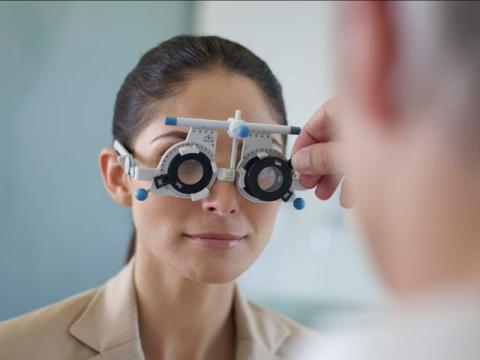 Dr Anand Shroff has been an Anterior segment and corneal surgeon for almost ten years. He has worked in great depth on the subjects of corneal diseases, keratoplasty, and astigmatic keratotomy. With this experience combined with his expertise on the Wavefront technology in LASIK, dissatisfied patients have often sought him after LASIK, PRK and RK for second opinions.
Dr Anand Shroff has been an Anterior segment and corneal surgeon for almost ten years. He has worked in great depth on the subjects of corneal diseases, keratoplasty, and astigmatic keratotomy. With this experience combined with his expertise on the Wavefront technology in LASIK, dissatisfied patients have often sought him after LASIK, PRK and RK for second opinions.
Our WaveLight 500 Hz Laser, especially because of its unique corneal tissue saving feature, enables us to re-treat corneas, which would have been otherwise too thin to work upon.
Some people who have already had LASIK with earlier technologies and experience night vision disturbances can be helped with our customized topography-guided treatments.
Wavefront measurements of LASIK patients with such quality of vision complaints may demonstrate a high magnitude of higher-order aberrations.
Studies demonstrate that topography or wavefront LASIK retreatments can reduce these aberrations as well as subjectively improve these night vision and contrast sensitivity problems. Each patient needs to be individually assessed to make proper suggestions.
Post-op Refractive Surgery Complication Management: Refractive surgery complications can be divided into those which are surgically induced and managed and those which are healing or ablation related and typically require further laser retreatment.
Examples of surgical complications would be:
- Corneal flap striae or displacement
- Epithelial Ingrowth
- Diffuse Lamellar Keratitis
- Corneal flap irregularities: button hole flap, free cap, short flap, thin flap
Examples of healing and ablation related complications are:
- Topographical abnormalities: decentrations, central islands, and peninsulas
- Spherical aberrations: night vision problems, night glare, halos, star-bursting, ghosting
- Irregular astigmatism: loss of best corrected spectacle vision
There is of course considerable cross-over as many surgically induced complications produce loss of contrast sensitivity, loss of best corrected vision and severe disturbances in night vision. While we have been managing surgical complications for several years, the development of wavefront technology has allowed us to finally fully evaluate all these patients and present possible treatment options for them. In about 70% of cases, we are now able to provide topographically guided solutions for patients. It is impossible however to predict which patients will be the most suitable candidates with the best chance of success until completing the diagnostic wavefront and topographical testing. The WaveLight 500 Hz Laser has been our excimer laser system of choice as the Tscherning wavefront analysis system has provided us with reproducible detailed data in the majority of cases for surgical planning.
The laser system also possesses specific features ideal for both the new patient and the post-refractive surgery patient for higher quality visual results:
- Laser spot size < 0.90 mm [0.63 mm half max.]
- Repetition rate 500 Hz
- True Effective Optical Zones upto 7 mm
- Infrared Eye-tracker with 2.5 msec response time and automatic centration
- Prolate cornea ( aspheric treatment patterns for classic and wavefront applications)
The small laser spot size is mandatory to produce fine complex treatment patterns. The rapid repetition rate is vital to maintain corneal hydration intra-operatively, especially in wavefront guided procedures with larger optical zones where a prolonged treatment time could adversely affect the planned treatment profile. A simple principle in laser refractive surgery is to keep the eye as physiologically hydrated as possible intra-operatively for a faster visual recovery with less risk of swelling and epithelial ingrowth. In cases of patients with night glare, the ability to create a prolate 7 mm true effective optical zone with a 9mm blend zone is highly beneficial. Lastly, the eye-tracking response time must be short enough to adequately account for saccadic eye movement. The Wavelight response time is better than any other excimer laser system without the need to dilate the pupil, which allows the patient to fixate on the target light more easily with a faster visual recovery.
For topography-linked retreatments, the WaveLight 500 Hz Laser has the best capabilities at present. It should be understood however that the diagnostic analysis is what determines the final treatment method of choice recommended to any individual patient.


 WhatsApp us
WhatsApp us